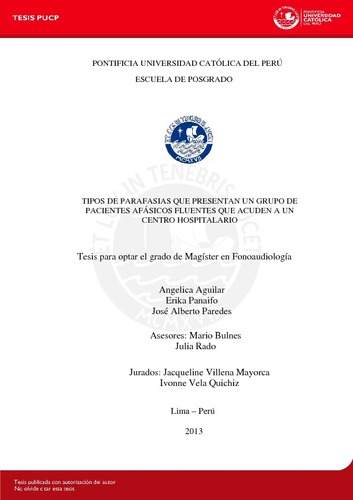| dc.contributor.advisor | Bulnes Bedón, Mario Santiago | |
| dc.contributor.advisor | Rado Triveño, Julia | |
| dc.contributor.author | Aguilar, Angelica | es_ES |
| dc.contributor.author | Panaifo, Erika | es_ES |
| dc.contributor.author | Paredes, José Alberto | es_ES |
| dc.date.accessioned | 2013-12-19T21:59:29Z | es_ES |
| dc.date.available | 2013-12-19T21:59:29Z | es_ES |
| dc.date.created | 2013 | es_ES |
| dc.date.issued | 2013-12-19 | es_ES |
| dc.identifier.uri | http://hdl.handle.net/20.500.12404/5069 | |
| dc.description.abstract | El objetivo de la investigación fue conocer los tipos de parafasias en un grupo de pacientes adultos afásicos fluentes que acuden a un Centro Hospitalario, a través del Test de Boston. La metodología que se utilizó fue descriptivo simple, y el estudio tuvo una duración de 5 meses contando con la participación de 6 pacientes.
A través de la presente investigación se logró conocer el tipo de parafasia que presenta cada paciente, encontrando en los resultados que existe una relación entre el tipo de afasia que presenta un paciente y el tipo de parafasia que emite en su habla, éstos resultados fueron contrastaron con la bibliografía consultada obteniendo coincidencias, es así que se observa en los pacientes con afasia de conducción mayor número de parafasias literales, en los pacientes con afasia de Wernicke mayor neologismos y en los pacientes con afasia anómica parafasias verbales y literales.
Palabras claves: Afasia, parafasia, Test de Boston | es_ES |
| dc.description.abstract | The main purpose of the research was to find out the types of paraphasias in fluent aphasic adult patients who visited a Hospital Center. Descriptive research method was used and, the study lasted five months with the participation of 6 patients.
Through this research is managed to meet the type of paraphasia each patient, finding the results that a relationship exists between the type of aphasia that presents a patient and the type of paraphasia emitted in their speech, these results were contrasted with the bibliography consulted obtaining coincidences, it is so noted in patients with conduction aphasia, greater number of literals phonemics, in patients with Wernicke aphasia most neologisms and anomic aphasia patients with paraphasiasverbal and literal. | es_ES |
| dc.language.iso | spa | es_ES |
| dc.publisher | Pontificia Universidad Católica del Perú | es_ES |
| dc.rights | Atribución-CompartirIgual 2.5 Perú | * |
| dc.rights | info:eu-repo/semantics/openAccess | es_ES |
| dc.rights.uri | http://creativecommons.org/licenses/by-sa/2.5/pe/ | * |
| dc.subject | Afasia. | es_ES |
| dc.subject | Trastornos del habla | es_ES |
| dc.title | Tipos de parafasias que presentan un grupo de pacientes afásicos fluentes que acuden a un centro hospitalario | es_ES |
| dc.type | info:eu-repo/semantics/masterThesis | es_ES |
| thesis.degree.name | Maestro en Fonoaudiología | es_ES |
| thesis.degree.level | Maestría | es_ES |
| thesis.degree.grantor | Pontificia Universidad Católica del Perú. Escuela de Posgrado | es_ES |
| thesis.degree.discipline | Fonoaudiología | es_ES |
| renati.advisor.dni | 08258705 | |
| renati.discipline | 916117 | es_ES |
| renati.level | https://purl.org/pe-repo/renati/level#maestro | es_ES |
| renati.type | http://purl.org/pe-repo/renati/type#tesis | es_ES |
| dc.publisher.country | PE | es_ES |
| dc.subject.ocde | https://purl.org/pe-repo/ocde/ford#3.05.03 | es_ES |






